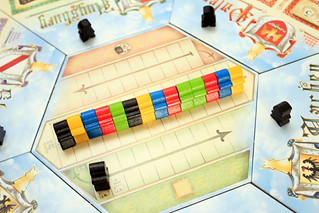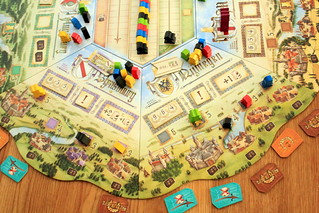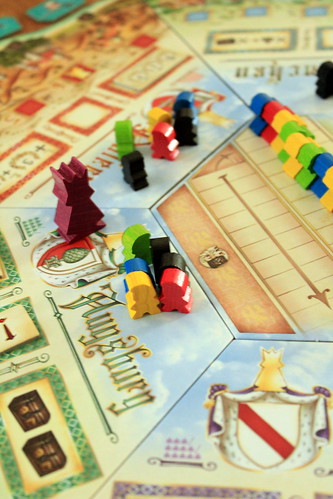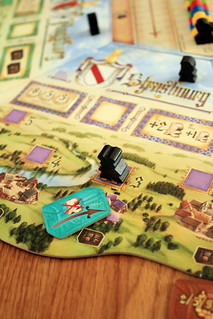| Strategy | Luck |
|---|---|
| Interaction | Components & Design |
| Complexity | Score |
That’s the setting of Andreas Steding’s The Staufer Dynasty (Z-Man Games, German edition is Die Staufer by Hans im Glück), and that’s also the end of our history lesson for this week, because the setting has less to do with how the game is played than usual for eurogames. Up to five players are princes at Henry’s court, traveling along with the goal of putting members of their family into influential positions in the six regions he might visit. The Staufer Dynasty is a majority game. You score points by having the most offices in a region when it’s scored. The rules for that are simple enough, but that doesn’t mean playing is easy.
The game lasts five rounds, each player has three actions per round in a variable order. Players take their actions in the order of their family members on the turn order track. Whoever is on top takes an action, then moves his fameeply member – yes, they are meeples – to the side. In the first round, that works out to first action clockwise, starting with the first player – duh – and the second and third action counterclockwise starting from the last. In later rounds, this gets more interesting, I promise.

When it’s your turn, you only have two options. First, you can move your fameeply member to the Supply Track on the left of the turn order track. Doing so allows you to take some meeples from the Province, your general supply, to the Court, your active supply. These are the meeples you can get into offices. They come as Enveeples – envoy meeples – and more valuable Nobles. I’m not making Nobles into any kind of meeples because nobleeples sounds awful even by my standards and meebles is not very distinctive. So they’ll just be Nobles. Deal with it.
The other action, sort of obvious at this point, lets you put those meeples in an office. You move your fameeply member to the Deploy Track, right from the Turn Order Track, and place a meeple in office. But offices don’t just happen, you have to pay for them with more meeples. To see how that works, lets have a quick look at the game board. The six regions form a circle around the small central board with the Turn Order and action tracks. Each region has three or more offices to take, each with a cost of three or more meeples. When an office costs three meeples, that means you place one meeple on the office space and one meeple each in the payment areas of the next two regions, always clockwise. They don’t really do anything there, after helping to put a cousin in office they will just chill for a while. That’s all when you take an office where the king is currently hanging out. To take an office anywhere else, you have to pay for the trip, too. In each region between the King and your destination you also leave a meeple in the payment area. You always travel clockwise, too, and that means in the worst case you pay five meeples for the trip plus seven meeple for the most expensive office. You must really want that seat if you’re willing to pay that, because those meeples are not only gone from the Court, they are also not in the Province. You can’t even take them back with a Supply action. It is quite possible to have all your 18 meeples on the board, leaving you unable to do anything and most likely not winning the game.

Why you even want those offices is easy to guess, too: they give you points to win the game. After each round, one or two regions are scored. One is known from the start of the game, five tiles are drawn and displayed, showing the name of a city to score that round. The other is more dynamic: you might score the region with the most meeples, or with the fewest remaining Treasure Chests (see below), or the region where the King is currently holding court. The condition that applies each round is also known from the start, but which region it will be is only determined when the round is over, and for the most meeples or fewest chests the players end up influencing which region will be scored, an important part of strategy. Scoring a region is quick and simple. All players count their meeples there, Enveeples count one point and Nobles count two, and the player with the highest number scores the highest number of points displayed in the region, the second player the second highest, and so on.
After the scoring, all meeples are removed from their offices in the regions just scored, and only there. I’m not exactly sure what the thematic idea behind that is, but I like to think that Henry was doing performance reviews, realized that all those people were only in office because of family connections and had them executed. Those meeples return to your Province. Having done that, the King travels clockwise from one to three regions. How far exactly is also known in advance, there is very little randomness or hidden information in The Staufer Dynasty. From every region he enters on his way, meeples in the payment area are returned to their owner’s Court. They’ll be ready to use immediately the next round. Always keep an eye on how far the King will travel, paying meeples you know will be returned to you for the next round is much less painful then paying meeples you’ll never see again. In a final step to prepare for the next round, you determine turn order. To do that, you first push all fameeply members from the Supply Track back to the Turn Order Track. They stay in the order they were in, so the first player to take a Supply action will go first in the next round. Then, you push all fameeply members from the Deploy track to the Turn Order track. They also remain in the order they were in, but the Deploy track is filled from the bottom up, so the first player to Deploy in one round will go last in the next. There are advantages to going early or late. Early means you’ll have a chance to pick cheaper offices, late gives you a better chance to decide majorities and what region will be scored. Where it will put you in turn order is another important consideration when picking an action.

Now there is still one more thing to factor into your strategy: Treasure Chests. Each office as well as each spot on the Supply Board – a small extra board where you pick what meeples to take when you Supply – starts with one Treasure Chest on it. The first player to take that office or pick that supply spot takes the Chest. After each round, every supply spot and every office in a region that was scored gets a new Chest, even if it had one already. With two or three Chests on, even unattractive spaces have a certain appeal. The Chests offer a variety of bonuses. Brown ones score points at the end of the game, more for larger sets of them. Orange Chests give their owner an immediate bonus, either points or meeples going from the Province to the Court. Turquoise Chests you keep and later discard them for a one time effect, like avoiding travel costs or keeping one of your meeples in office after a region was scored. Finally, two purple Chests can be exchanged for a Privilege Card, powerful bonus cards that score additional points or give you some other advantage, for instance you may have a card that lets you buy every office for three meeples, even if the printed cost is higher. All those Chests are open, by the way, you always know what you will get. Like I said, there is very little hidden information in this game. Of course that doesn’t make decisions any easier.
The one bit information that is hidden comes into play at the very end of the game. After the last round, there is still a final scoring. The points you get here are based on Job Cards each player received at the start of the game, and of those you only know your own, not the other players’. These cards come in three types, and you’ll have one of each. The first names a region, and you score bonus points for having the majority there when the game ends. The second shows a pattern, for example “two regions separated by exactly one region”, and if you have meeples in regions forming that pattern they will score a bonus. The third bonus applies to your offices, you might score for all offices with a certain value, or for pairs of offices with the same value.

Between three different endgame score cards, chests, turn order for the next round, having enough meeples for the next round, influencing what regions will score this round and actually getting majorities in the regions that will score, you see that every move in The Staufer Dynasty has a long list of considerations attached to it, and it’s mostly not obvious which one you should give priority right now. Tactical necessities – I need this office right now because that Chest is valuable for me – compete with strategic goals – that other region would complete my pattern card. Despite that, the rules are brief, easy and consistent. After reading the explanation above, you’re almost ready to play, you’d only be missing some details like tie breakers. And while there are many factors to consider, each move is still short enough that downtime is not an issue, even with some deep thinkers on the table. Even with all your meeples at the bottom of the turn order in a five player game, you won’t get bored before it’s your turn again. You also shouldn’t get bored in the long term, there is not much randomness in the game itself, but the setup turns out different every time. Most pieces of the board are also double-sided and turned depending on the number of players, making sure that there is just the right amount of space – slightly less than you want – with every number of players.
Besides all that, The Staufer Dynasty is also a great game to look at. The illustration on the huge, round board are yet another great job by Franz Vohwinkel, looking good and showing everything you need to know clearly at a glance. With a zoo of colorful meeples standing around on the board, the whole thing looks great. Really, the only thing I can think to nag about is the disconnect between theme and mechanics. But lets be honest here, that’s a criticism that can be directed at most European style games, and it really doesn’t bother us when the game is this good. For me, The Staufer Dynasty is a strong candidate for Kennerspiel des Jahres this year. We’ll see if the jury agrees when they announce the nominees next week.















